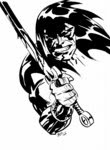Screengrab : Overlord

The image above is the key shot from "Overlord", Stuart Cooper's beautiful 1975 film of World War II. I avoid using the phrase "War film", because while "Overlord" is about the Second World War, about a common soldier's experience of that War from training to battlefield, and about so much more besides, it contains no scenes of combat. In that sense and a few others, "Overlord" is a unique piece of cinema.
Part of its oddness stems from the circumstances of its production. It was produced by the Imperial War Museum, who have been heavily involved in the production of plenty of documentary films and television series - most famously with the superb "The World At War" - but had never before (or since, to my knowledge) produced an actual Feature Film. Expatriate American director Stuart Cooper, whose last film "Little Malcolm" had just won the Silver Bear at the Berlin Film Festival, was attached, and he wrote a screenplay with Christopher Hudson which manages to tell the intimate story of one young conscript's journey through the months leading up to D-Day while also showcasing the Museum's unmatched collection of archive footage from that period. Cinematographer John Alcott, who was Stanley Kubrick's regular collaborator throughout the 1970s, was hired to shoot the film, and using vintage German lenses he managed to achieve a seamless blend between the archive footage and the material shot specially for the film.
It is a visually lovely film, with Alcott's crisp photography and the perfectly-judged editing establishing a strange dreamlike mood I've never seen in any other film about War. As Tom, Brian Stirner - who is a dead ringer for Michael Sheen - is a sensitive lead, allowing his character some very human flaws in his prissiness and strange distance. The film is mainly concerned with his training and preparation for the Normandy landings, and Cooper makes much of the military as a dehumanising machine into which men simply vanish. Tom makes this explicit in a letter he writes but never sends to his parents: "The war machine keeps growing, and I am getting smaller and smaller". He drifts off into occasional reveries and daydreams throughout the film, many of them seemingly premonitions of his own death, which he sees as certain. These scenes are poetically assembled by Cooper, who uses repetetive, startling compositions for associative effect. Tom's final kiss with a girl he meets just prior to the invasion is depicted taking place upon a landing craft heading for a French beach.

The film itself has its own reveries and tangents. It periodically drifts away from Tom and his friends to reveal the panorama of the War itself, always being fought somewhere, claiming and changing lives at every moment. All of the archive footage is breathtaking and some of it shocking. We witness London firemen fighting a firestorm which rages through streets, toppling buildings onto pavements. We see footage from the nose camera of a fighter plane, tracer rounds describing the arcs of bullets into planes, locomotives and buildings as tiny figures run for cover and eject into empty sky. We are shown bombs dropping slowly, terribly towards towns and villages, then watch shockwaves and explosions hammer the landscape as they find targets below. We watch the preparations for D-Day, men thrown about like dolls by the waves of the British coastline, huge War Machines designed to cut barbed wire and forge through minefields rolling on the beaches of England. German cities burn in the night, miles and miles of streets and factories on fire. Children boarding trains to escape London in the blitz, American soldiers flirting with an Englishwoman waving their train off, Tommys playing cards and boxing and idling as they wait for the invasion to begin. All of it fascinating and beautifully interwoven with Tom's story, which ends on the Red Beach at Normandy. Here Cooper is obviously inspired by the legendary American War Photographer Robert Capa and his shots of both that operation and the Spanish Civil War, as he describes on a documentary on the recent Criterion Collection edition of "Overlord" on DVD.

"Overlord" also contains echoes of the work of British directors Peter Watkins and Kevin Brownlow, and even Gillo Pontecorvo, in its stark beauty, poetic realism and honesty. It enjoyed some success in Europe upon its release, winning Cooper a second Silver Bear at Berlin, but didn't receive an American release until 2006. Perhaps its tone - sombre and almost quizzical in an inimitably British manner, not remotely angrily anti-War, as was the fashion of many American War films during the Vietnam era - was seen as off-putting to Americans at the time. But it is a singular and brilliant film, and Cooper's relative obscurity since its release is puzzling. He made one more film before retreating to work exclusively in television until the present day.
But "Overlord" has had some influence on other treatments of war. Kubrick's "Full Metal Jacket" is extremely reminiscent of "Overlord" in its training sequences, while Spielberg must have been aware of it when he came to shoot "Saving Private Ryan" and decided to use a handheld, chaotic shooting style similar to Cooper's treatment of D-Day. But nothing since has really attempted the same mix of realism and poetry that "Overlord" does with such success, and that is the films greatest achievement.
Labels: film



2 Comments:
Ok mission accomplished, I want to see this film I previously hadn't heard of and knew nothing about.
It sounds good.
It is very very good. But unavailable in the UK. Boooo.
Post a Comment
<< Home